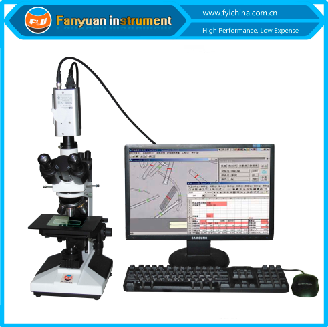Maximize Your Fibre Optic Efficiency: Recognizing Optical Fibre Size Analyser Technology
The performance of fibre optic systems is critically affected by the accuracy of their size, a variable usually neglected in the pursuit of optimum signal honesty. Understanding the modern technology behind optical fibre size analysers reveals the intricate equilibrium in between measurement precision and manufacturing quality.
Relevance of Optical Fiber Diameter
The diameter of optical fiber plays an important role in determining the performance and effectiveness of interaction systems. Conversely, smaller sizes tend to sustain fewer settings, which can improve signal clarity and reduce crosstalk.

Furthermore, understanding the size's effects can bring about cost savings by minimizing the requirement for signal amplification and repeaters in comprehensive networks (optical fibre diameter analyser). Finally, the relevance of optical fiber size can not be overemphasized, as it straight impacts the overall performance and reliability of contemporary interaction systems

Exactly How Size Impacts Signal Quality
Signal top quality in optical fiber systems hinges dramatically on the size of the fiber. A smaller diameter can lead to higher attenuation rates, resulting in signal loss as light trips through the fibre.
On the other hand, bigger diameters typically enable improved light capture and lowered modal dispersion, improving signal clarity. In multimode fibres, a larger core size can sustain several light settings, however it may also present intermodal diffusion, which can deteriorate signal quality. Consequently, choosing the optimum fiber diameter is important for achieving the desired performance in particular applications.
Additionally, the communication between the fibre size and the wavelength of the light utilized plays an essential role in figuring out the efficient transmission distance and general signal honesty. Comprehending exactly how fibre size affects signal quality is essential for network designers and designers making every effort to maximize optical fibre systems for dependable, high-speed information transmission.
Overview of Diameter Analyser Innovation
In lots of optical fibre manufacturing processes, exact dimension of fibre diameter is vital for ensuring constant performance and top quality (optical fibre diameter analyser). Size analysers are sophisticated instruments created to assess the physical measurements of optical fibers with high precision. They employ advanced optical and laser modern technologies to measure the size, ovality, and concentricity of the fibre, thus providing essential information for top quality control
These analysers can operate in-line during the production procedure or as component of off-line screening methods. In-line systems enable real-time surveillance, enabling suppliers to change criteria immediately, consequently keeping optimal manufacturing conditions. Off-line analysers, on the various other hand, give comprehensive assessments of batches, making certain that any inconsistencies from defined tolerances are identified and dealt with.
Diameter analysers dramatically contribute to the reduction of flaws in optical fibres, enhancing general item dependability. By continually measuring vital parameters, these innovations assist in conformity with market standards and specs. As the need for high-performance optical fibers remains to rise, the duty of diameter analysers ends up being increasingly vital in achieving the preferred high quality and efficiency criteria in fibre optic systems.
Secret Attributes of Fiber Size Analysers
Although different versions of fibre diameter analysers exist, they frequently share numerous key attributes that boost their functionality and integrity. Among one of the most considerable functions is high-resolution dimension abilities, which ensure specific size readings, crucial for preserving quality assurance in fiber manufacturing. Additionally, many analysers integrate advanced optical sensing read the full info here units created to detect minute variants in fibre size, therefore providing very useful information for process optimization.
An additional vital function is real-time tracking, enabling drivers to obtain immediate feedback on fiber diameter throughout the manufacturing process (optical fibre diameter analyser). This capability promotes rapid adjustments and reduces the likelihood of flaws. Several analysers additionally come outfitted with easy to use user interfaces, enabling drivers to quickly navigate through information and settings results
In addition, durable information storage space and analysis functionalities are vital for tracking historic efficiency fads and making certain conformity with sector requirements. Some designs also offer connectivity options for assimilation into existing production control systems, improving total operational efficiency. Portable and small layouts permit for adaptable release within production environments, making certain that quality assurance processes are seamless and efficient. These features collectively add to the efficacy of fiber diameter analysers in optimizing fibre optic performance.
Best Practices for Fiber Optimization

First, routine calibration of optical fibre diameter analysers is necessary. This guarantees exact measurements and reduces prospective disparities that can influence efficiency. Next off, maintaining a tidy workplace is essential; dust and impurities can lead to signal destruction.
Additionally, it is very important to pick fibres that meet specific application needs. This entails examining elements such as attenuation, transmission capacity, and ecological problems. Correct installation methods must likewise be followed, including preventing sharp bends and too much tension, which can endanger fibre stability.
Moreover, using advanced monitoring systems can assist in real-time performance evaluations, making it possible for prompt recognition of concerns. Normal screening and upkeep need to be conducted to make sure that fibers continue to be within optimal functional criteria.
Lastly, training employees on the most recent fiber optimization technologies and methodologies will certainly boost their capacity to carry out reliable strategies. By adhering to these finest methods, companies can dramatically improve the performance and lifespan of their optical fiber systems, making sure efficient interaction and data transfer.
Final Thought
To conclude, the assimilation of optical fiber size analyser innovation is critical for making best use of fiber optic performance. By making sure accurate dimensions of fiber measurements, these analysers substantially enhance signal high quality and reduce losses during data transmission. Regular calibration and maintenance of the analysers are necessary to maintain optimal performance and recommended you read conformity with sector requirements. Inevitably, the application of this technology facilitates boosted data transmission rates click over here now and enhances signal honesty, adding to the overall performance of fibre optic systems.
Signal quality in optical fiber systems pivots considerably on the size of the fiber.In many optical fibre manufacturing procedures, exact measurement of fiber size is vital for making certain consistent performance and high quality. As the demand for high-performance optical fibres continues to increase, the duty of diameter analysers comes to be significantly crucial in accomplishing the wanted high quality and performance standards in fiber optic systems.
These functions jointly add to the effectiveness of fiber diameter analysers in maximizing fiber optic efficiency.
In verdict, the combination of optical fibre diameter analyser technology is critical for maximizing fibre optic performance.
 Devin Ratray Then & Now!
Devin Ratray Then & Now! Christina Ricci Then & Now!
Christina Ricci Then & Now! Jennifer Love Hewitt Then & Now!
Jennifer Love Hewitt Then & Now! David Faustino Then & Now!
David Faustino Then & Now! Nadia Bjorlin Then & Now!
Nadia Bjorlin Then & Now!